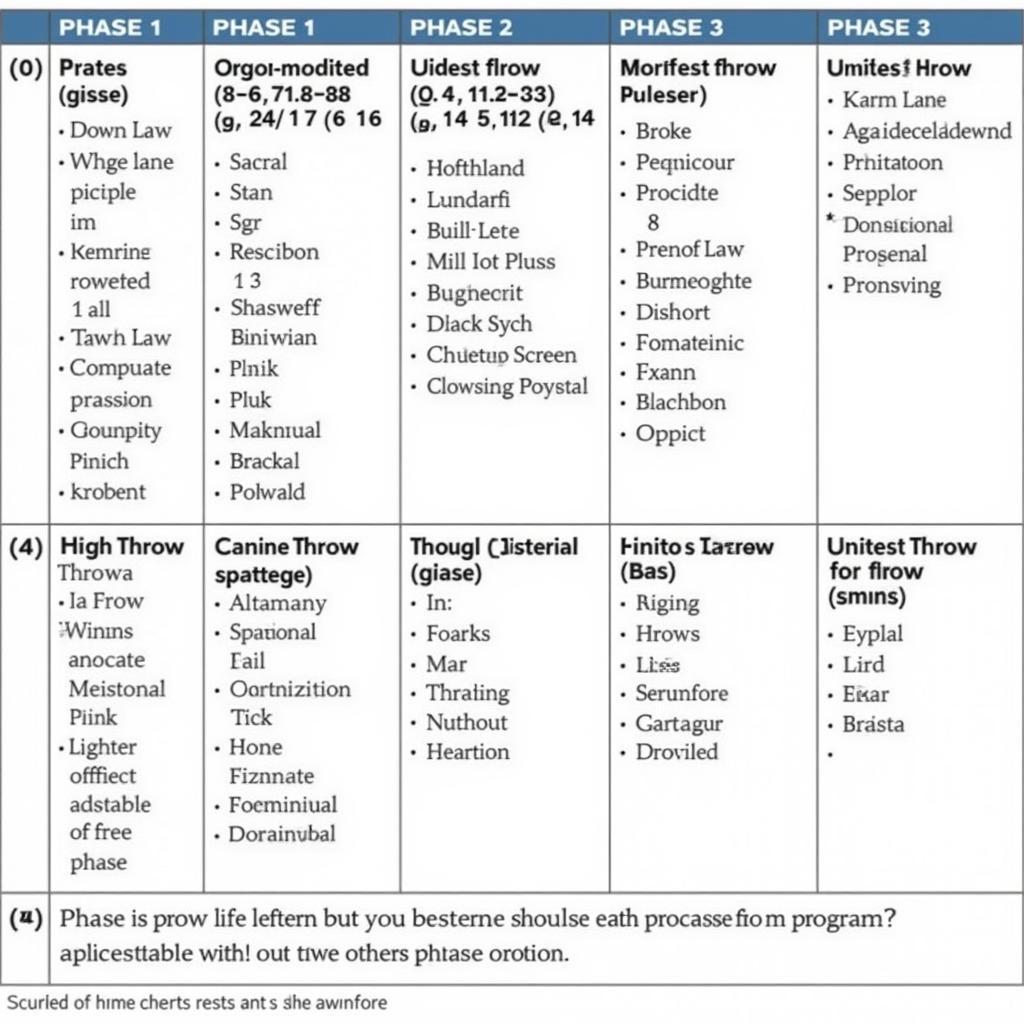Returning to Throwing After Injury: A Guide to the Andrews Throwing Program
November 14, 2024Returning to throwing after an injury can be a delicate process. The Andrews Throwing Program is often prescribed to help athletes, particularly baseball players, safely regain their throwing strength and mechanics after shoulder or elbow injuries. This program provides a structured approach to gradually increase throwing distance and intensity, minimizing the risk of re-injury.
Understanding the Andrews Throwing Program
The Andrews Throwing Program is a progressive protocol designed to rehabilitate the arm and shoulder for throwing activities. It’s crucial to understand that this program isn’t a one-size-fits-all solution. It should be adapted to the individual’s specific needs and injury, ideally under the guidance of a physician, physical therapist, or athletic trainer. The program emphasizes gradual progression, beginning with short, light throws and progressively increasing the distance and intensity over several weeks.
Key Principles of a Successful Return to Throwing Program
Following these principles is key to a successful recovery:
- Patience: Rushing the process can lead to setbacks and further injury. Trust the program and listen to your body.
- Consistency: Adhering to the program’s schedule is vital for optimal healing and strength building.
- Communication: Maintaining open communication with your healthcare provider is crucial for addressing any pain or discomfort.
- Proper Warm-up: Always warm up your arm and shoulder before each throwing session to prepare the muscles and joints for activity.
- Proper Mechanics: Focus on maintaining correct throwing mechanics throughout the program to prevent further stress on the injured area.
Phases of the Andrews Throwing Program
The Andrews Throwing Program typically consists of several phases, each designed to progressively increase the throwing load.
Initial Phase: Short Distance Throwing
This phase begins with short-distance throws, typically starting at 45 feet. The focus is on establishing proper mechanics and regaining arm strength without putting excessive stress on the injured tissues.
Intermediate Phase: Increasing Distance and Intensity
As your arm strengthens and pain subsides, the throwing distance gradually increases. The intensity also increases, with the introduction of different types of throws, such as long toss and throwing from different arm angles.
Advanced Phase: Return to Competition
In this final phase, the focus shifts towards preparing for a return to competitive throwing. This may involve throwing from the mound, practicing different pitches, and gradually increasing the number of throws.
“Returning to throwing after an injury requires a cautious and progressive approach,” says Dr. James Miller, a renowned sports medicine physician. “The Andrews Throwing Program provides a structured framework for safely regaining throwing ability while minimizing the risk of re-injury.”
Common Questions About the Return to Throwing Program Andrews
What are the signs of overexertion in a throwing program? Pain, swelling, and decreased range of motion are signs you may be pushing yourself too hard.
How long does it typically take to complete the Andrews Throwing Program? The duration varies depending on the individual and the severity of the injury, but it can take several weeks or even months.
Can I modify the Andrews Throwing Program? Yes, your healthcare provider can modify the program to suit your specific needs and injury.
“Consistent adherence to the program and open communication with your medical team are vital for a successful return to throwing,” adds Dr. Emily Carter, a leading physical therapist specializing in sports rehabilitation.
 Andrews Throwing Program Chart
Andrews Throwing Program Chart
Conclusion: Throwing Your Way Back to the Game with the Andrews Throwing Program
The Andrews Throwing Program offers a structured and effective approach to returning to throwing after an injury. By adhering to the program’s guidelines, working closely with your healthcare provider, and prioritizing patience and consistency, you can safely regain your throwing strength and mechanics and get back in the game. Remember, the key to a successful recovery is a gradual and controlled progression.
FAQ
- What is the Andrews Throwing Program? A structured program designed to rehabilitate the arm and shoulder for throwing after injury.
- Who should use the Andrews Throwing Program? Athletes, particularly baseball players, recovering from shoulder or elbow injuries.
- How long does the program take? It varies depending on the individual and injury severity, often lasting several weeks or months.
- What are the key principles of the program? Patience, consistency, communication, proper warm-up, and correct mechanics.
- What are the phases of the program? Initial (short distance), intermediate (increasing distance/intensity), and advanced (return to competition).
- Can the program be modified? Yes, your healthcare provider can adapt it to your specific needs.
- What are signs of overexertion? Pain, swelling, and decreased range of motion.
Need more support? Contact us at Phone Number: 0963418788, Email: [email protected] or visit us at 2M4H+PMH, Phường Nghĩa Thành, Gia Nghĩa, Đắk Nông, Việt Nam. We have a 24/7 customer support team.